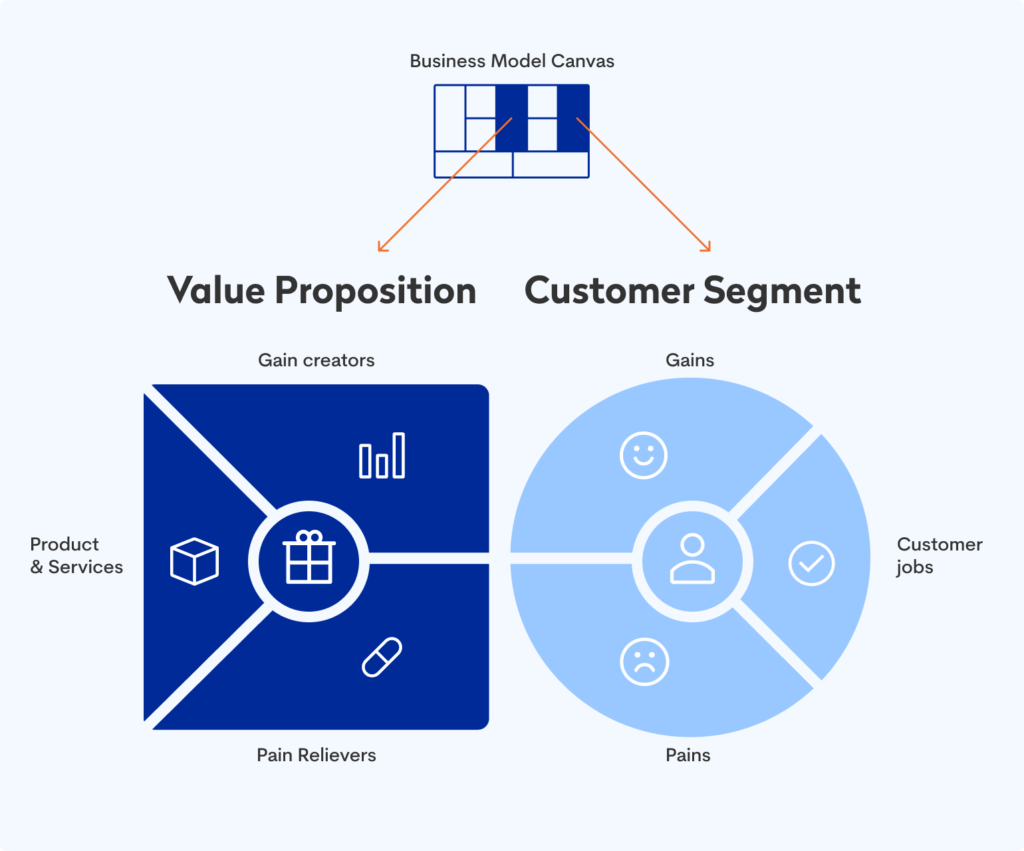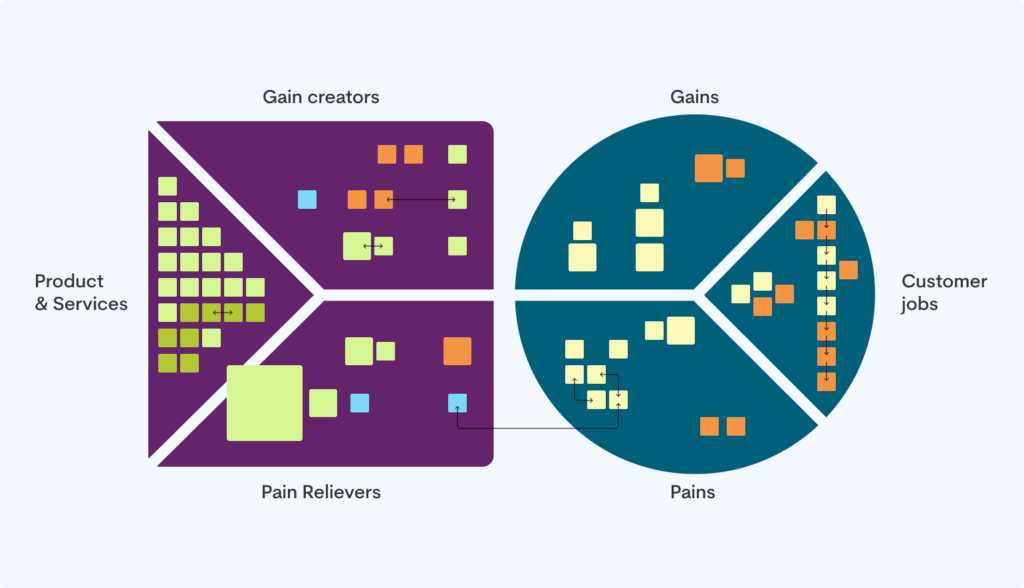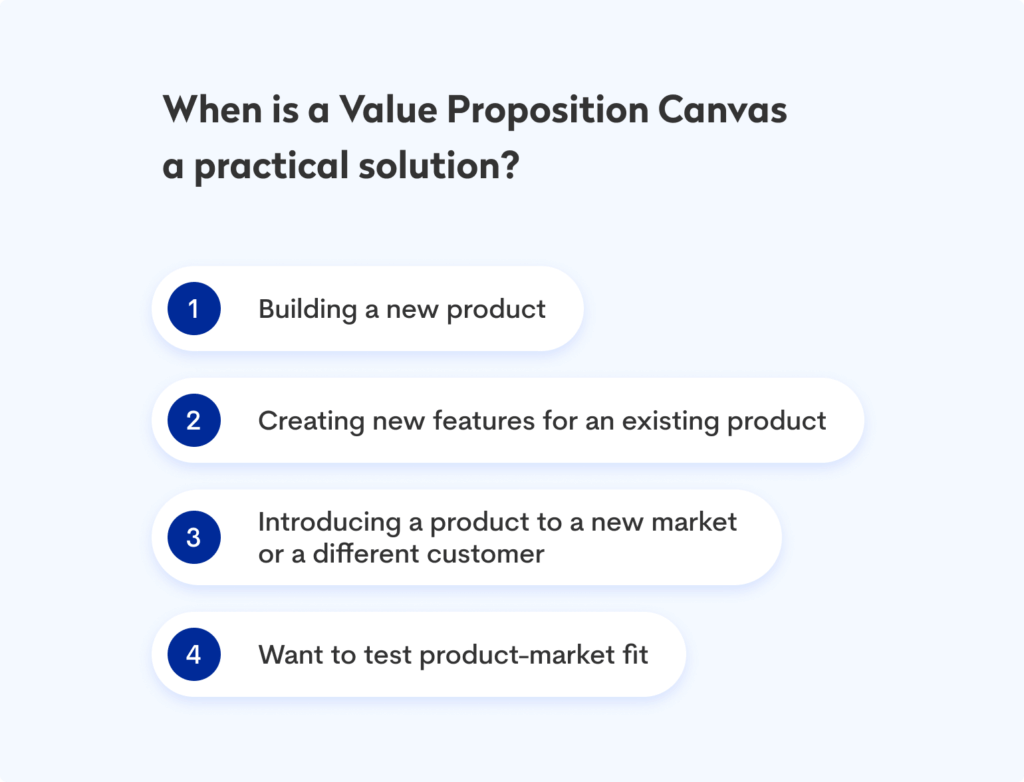When creating a new product, the primary goal is understanding the customer’s needs and finding ways to meet them. Why is this so important? Because even if you have an excellent idea for a product, there is no guarantee that you will find users who will use it.
What do you need in that case? To start with, you need an understanding of what value your application creates in the customer’s life. If you’re a startup founder using the value proposition canvas, a practical solution prepared during the product workshop at the discovery stage is worthwhile.
In a structured and visual way, it makes it easier to analyze, design, and select the right solutions for your users’ needs.
What is a VPC (Value Proposition Canvas), a unique value canvas? What elements does it consist of? And finally, what benefits will you gain from preparing and thoroughly analyzing the needs of your product’s audience? You will find out in the rest of this article.
Value Proposition Canvas – what is it?
A value proposition canvas is a structure that helps match a product with the needs of users in the market. The history of this tool began in 2004 when Dr Alexander Osterwalder presented his research on business models. He created a more encompassing tool known as the Business Model Canvas. While it is a practical aid for testing ideas and revealing flaws and risks your project may face, it lacks a clear customer focus. To that end, Osterwalder proposed augmenting two fields in a separate template to isolate user needs and focus on them. From this moment, it was termed the Value Proposition Canvas (VPC).
This analysis’ purpose is to take us from problem to solution in an orderly, thoughtful manner. It makes it easier to capture underlying issues related to customer needs and find potential solutions. The VPC can be used whether you create a new product from scratch or need to improve an existing solution.
What does the Value Proposition Canvas template consist of?
At first glance, the VPC template consists of a large square on the left with a circle on the right. This geometric collage represents a product’s value proposition based on customer needs. The arguments gathered together are intended to convey what features and functionalities the application should have to meet the requirements of a specific category of users. Now, we will discuss this in more detail.

The value proposition canvas consists of two main elements – the customer profile and the product value proposition.
The customer profile is created for each user who will be the application recipient, since each customer segment has distinct „tasks to be performed.” These tasks define the different problems and benefits. Ideally, the analysis starts by considering the customer profile data in the wheel. It is divided into three parts: jobs, pains, and gains.
Customer
- Gains – these are the positive effects that the user expects regarding tasks. Benefits can include positive emotions, savings, increased profits, and anything that makes the customer happy.
- Pains – these are the negative experiences, emotions, and risks the customer experiences while doing the work.
- Tasks – these are the jobs that recipients do daily – functional, social, and emotional. We are particularly interested in prioritizing issues addressing the client’s main problem. These can be social tasks (resulting from an organization’s role), needs (resulting from likes and feelings), or classic functional work the client performs daily.

Product & Services
The square on the canvas represents a value proposition map. Like the circle, it is divided into three separate sections.
- Product & Services – This is where we list product features and options that benefit and alleviate pain. They are the basis for creating value for the customer.
- Gain creators – This describes how the product or service produces benefits and value for the customer, such as helping to achieve specific goals. Anything that offers something new or improves the user experience is worth mentioning here. For example, a product provides cost savings and delivers the customer’s desired results.
- Pain relievers – It is a detailed description of the features and activities, including how the product or service reduces the customer’s pains. This should correspond to the pains listed in the customer profile. For example, it could be about cost savings, reducing risks, or fixing flaws in existing solutions.
The main advantages of Value Proposition Canvas
The VPC is more than a graphical representation of customers’ wishes. It is critical to the business model and the profitability and success of the built product. It is part of the product workshop where we analyze the product’s technical and business aspects. Especially in the business aspect, the product promotion strategy should be strongly considered. It helps create a product that customers desire.
Let’s now take a look at the three most important advantages of the value proposition canvas:
- Focused planning
The more product ideas we have, the easier it is to stop focusing on our main priorities. As a result, the developed product may not meet customer expectations. This is not what you expect as a startup owner. On the other hand, a value proposition canvas visually provides clues to help focus on the most important product features that affect customer satisfaction. It makes it easier to envision what features and functionalities a product should have to be in demand. It keeps us focused rather than distracted.
- Strong customer engagement
Customer satisfaction is the most critical factor in product development. The value proposition canvas involves accurately identifying and meeting essential needs. The advantage of this scheme is that the template allows you to focus on the elements that customers value most. You will avoid irrelevant details, such as unnecessary features or elaborate user interfaces.
- The right message is a compelling marketing
Launching a new product involves significant marketing and branding efforts. It communicates to customers how buying the product will meet their needs. This helps build a strong brand image in the minds of consumers.
This is where the value proposition canvas demonstrates its assistance. It identifies the user’s needs and develops an action. This makes it easy to promote and advertise to catch customers’ attention. The better knowledge you gather about the customer segment and the target characteristics of the product you are offering, the easier it will be when handling comprehensive brand promotional activities.
When is it good to create a unique value canvas?
According to experienced project managers, the main advantage of a canvas is to pay attention to the core areas of customer value creation – benefits and pains. Completing proper analysis makes finding a unique value proposition for your startup and the product you create easier.
When is the value proposition canvas a practical solution?
1. You are building a new product
This is a good starting point for conceptual work on your idea, especially when building a new application. It doesn’t require you to prepare a complete business model immediately. Still, learning about customer needs and analyzing available solutions makes it easier.
2. You are creating new features for an existing product
You can use a VPC when you plan to develop a new feature for a current product. Because it helps you understand your audience and their problems, you can see if the feature will solve any problem or benefit your users.
3. You are introducing a product to a new market or another customer
Another use is using a VPC to expand into new markets. Filling out a VPC can help you see if the market really needs you or not. You also understand your service and current customer problems. This enables you to make the right decision.
4. You want to test product-market fit
A Value Proposition Canvas can help you find the best product-market fit. It enables you to understand your market and develop a product that meets their real needs, increasing your chances of success.
 Conclusions
Conclusions
Let’s recall some key findings:
The value proposition canvas comes from the business model. It is a graphic expression of customers’ needs and highlights problems for them. It also reveals what the product can offer to deal with it. Furthermore, it provides a practical tool for analyzing the business and discovering ways to improve it. Moreover, it is a beneficial method of analyzing user needs. It will be valid for startup owners and entrepreneurs who want to improve their businesses.
From our side, we recommend you give it a try and see how the unique value proposition works. We are confident that you will like the effect of its operation, as we have tested how practical a tool, it has turned out to be in our clients’ projects. Please contact us if you have questions about how the such analysis goes or what a full product workshop looks like. We’ll be happy to talk about your project needs.


